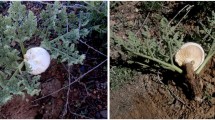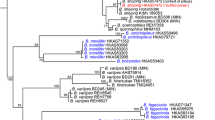Abstract
Sanghuang is a medicinal mushroom that has gained particular attention in Korea. It has been extensively studied for the past few decades as a natural immune booster and cancer suppressor. Although the scientific name, Phellinus linteus, has been commonly used to refer to the sanghuang mushroom, the species identity of sanghuang has been called into question due to the ambiguity of its circumscription and the inadequacy of morphological distinctions within allied species. Because the species concept of sanghuang has been elucidated by recent molecular phylogenetic studies, it has become necessary to clarify the taxonomic positions of sanghuang strains extensively utilized in Korea. We conducted a phylogenetic analysis of 74 strains belonging to the P. linteus-baumii complex based on ITS nrDNA sequences. Parental stains of sanghuang varieties formally registered in the Korea Seed & Variety Service, including ASI 26046 (Corea sanghuang), 26114 (Boolro), and 26115 (HK 1-ho) were grouped with Sanghuangporus sanghuang instead of P. linteus in the inferred phylogeny.
Similar content being viewed by others
References
Chen, W., He, F.Y., and Li, Y.Q. 2006. The apoptosis effect of hispolon from Phellinus linteus (Berkeley & Curtis) Teng on human epidermoid KB cells. J. Ethnopharmacol. 105, 280–285.
Cho, J.H., Cho, S.D., Hu, H., Kim, S.H., Lee, S.K., Lee, Y.S., and Kang, K.S. 2002. The roles of ERK1/2 and p38 MAP kinases in the preventive mechanisms of mushroom Phellinus linteus against the inhibition of gap junctional intercellular communication by hydrogen peroxide. Carcinogenesis 23, 1163–1169.
Choi, Y.H., Huh, M.K., Ryu, C.H., Choi, B.T., and Jeong, Y.K. 2004. Induction of apoptotic cell death by mycelium extracts of Phellinus linteus in human neuroblastoma cells. Int. J. Mol. Med. 14, 227–232.
Collins, L., Zhu, T., Guo, J., Xiao, Z.J., and Chen, C.Y. 2006. Phellinus linteus sensitises apoptosis induced by doxorubicin in prostate cancer. Br. J. Cancer 95, 282–288.
Dai, Y.C. 2010. Hymenochaetaceae (Basidiomycota) in China. Fungal Divers. 45, 131–343.
Dai, Y.C. and Xu, M.Q. 1998. Studies on the medicinal polypore, Phellinus baumii, and its kin, P. linteus. Mycotaxon 67, 191–200.
Guo, J., Zhu, T., Collins, L., Xiao, Z.X., Kim, S.H., and Chen, C.Y. 2007. Modulation of lung cancer growth arrest and apoptosis by Phellinus linteus. Mol. Carcinog. 46, 144–154.
Hall, T.A. 1999. BioEdit: a user-friendly biological sequence alignment editor and analysis program for Windows 95/98/NT. Nucl. Acids Symp. Ser. 41, 95–98.
Han, S.B., Lee, C.W., Kang, J.S., Yoon, Y.D., Lee, K.H., Lee, K., Park, S.K., and Kim, H.M. 2006. Acidic polysaccharide from Phellinus linteus inhibits melanoma cell metastasis by blocking cell adhesion and invasion. Int. Immunopharmacol. 6, 697–702.
Hasegawa, M., Kishino, H., and Yano, T. 1985. Dating of humanape splitting by a molecular clock of mitochondrial DNA. J. Mol. Evol. 22, 160–174.
Kim, G.Y., Oh, W.K., Shin, B.C., Shin, Y.I., Park, Y.C., Ahn, S.C., Lee, J.D., Bae, Y.S., Kwak, J.Y., and Park, Y.M. 2004. Proteoglycan isolated from Phellinus linteus inhibits tumor growth through mechanisms leading to an activation of CD11c+CD8+ DC and type I helper T cell-dominant immune state. FEBS Lett. 576, 391–400.
Larsson, K.H., Parmasto, E., Fischer, M., Langer, E., Nakasone, K.K., and Redhead, S.A. 2006. Hymenochaetales: a molecular phylogeny for the hymenochaetoid clade. Mycologia 98, 926–936.
Lee, H.J., Lim, E.S., Ahn, K.S., Shim, B.S., Kim, H.M., Gong, S.J., Kim, D.K., and Kim, S.H. 2005. Cambodian Phellinus linteus inhibits experimental metastasis of melanoma cells in mice via regulation of urokinase type plasminogen activator. Biol. Pharm. Bull. 28, 27–31.
Lee, S. and Taylor, J. 1990). Isolation of DNA from fungal mycelia and single spores, pp. 315–322. In Innis M.A., Gelfand, D.H., Sninsky, J.J., and White, T.J. (eds.), PCR Protocols: a guide to methods and applications, Academic Press, San Diego, USA.
Lim, Y.W., Lee, J.S., and Jung, H.S. 2003. Type studies on Phellinus baumii and Phellinus linteus. Mycotaxon 85, 201–210.
Swofford, D.L. 2003. PAUP*. Phylogenetic Analysis Using Parsimony (*and Other Methods). Version 4. Sinauer Associates, Sunderland, Massachusetts, USA.
Thompson, J.D., Higgins, D.G., and Gibson, T.J. 1994. CLUSTAL W: improving the sensitivity of progressive multiple sequence alignment through sequence weighting position specific gap penalties and weight matrix choice. Nucleic Acids Res. 22, 4673–4680.
Wagner, T. and Fischer, M. 2001. Natural groups and a revised system for the European poroid Hymenochaetales (Basidiomycota) supported by nLSU rDNA sequence data. Mycol. Res. 105, 773–782.
Wagner, T. and Fischer, M. 2002. Proceedings towards a natural classification of the worldwide Phellinus and Inonotus s. l., and phylogenetic relationships of allied genera. Mycologia 94, 998–1016.
White, T.J., Bruns, T., Lee, S., and Taylor, J.W. 1990). Amplification and direct sequencing of fungal ribosomal RNA genes for phylogenetics. pp. 315–322. In Innis, M.A., Gelfand, D.H., Sninsky, J.J., and White, T.J. (eds.), PCR protocols: A Guide to Methods and Applications. Academic Press, Inc., New York, USA.
Wu, S.H., Dai, Y.C., Hattori, T., Yu, T.W., Wang, D.M., Parmasto, E., Chang, H.Y., and Shih, S.Y. 2012. Species clarification for the medicinally valuable ‘sanghuang’ mushroom. Bot. Stud. 53, 135–149.
Zhou, L.W., Vlasak, J., Decock, C., Assefa, A., Stenlid, J., Abate, D., Wu, S.H., and Dai, Y.C. 2015). Global diversity and taxonomy of the Inonotus linteus complex (Hymenochaetales, Basidiomycota): Sanghuangporus gen. nov., Tropicoporus excentrodendri and T. guanacastensis gen. et spp. nov., and 17 new combinations. Fungal Divers. doi: 10.1007/s13225-015-0335-8
Zhu, T., Guo, J., Collins, L., Kelly, J., Xiao, Z.J., Kim, S.H., and Chen, C.Y. 2007. Phellinus linteus activates different pathways to induce apoptosis in prostate cancer cells. Br. J. Cancer 96, 583–590.
Zhu, T., Kim, S.H., and Chen, C.Y. 2008. A medicinal mushroom: Phellinus linteus. Curr. Med. Chem. 15, 1330–1335.
Author information
Authors and Affiliations
Corresponding author
Rights and permissions
About this article
Cite this article
Han, JG., Hyun, MW., Kim, C.S. et al. Species identity of Phellinus linteus (sanghuang) extensively used as a medicinal mushroom in Korea. J Microbiol. 54, 290–295 (2016). https://doi.org/10.1007/s12275-016-5520-2
Received:
Revised:
Accepted:
Published:
Issue Date:
DOI: https://doi.org/10.1007/s12275-016-5520-2




